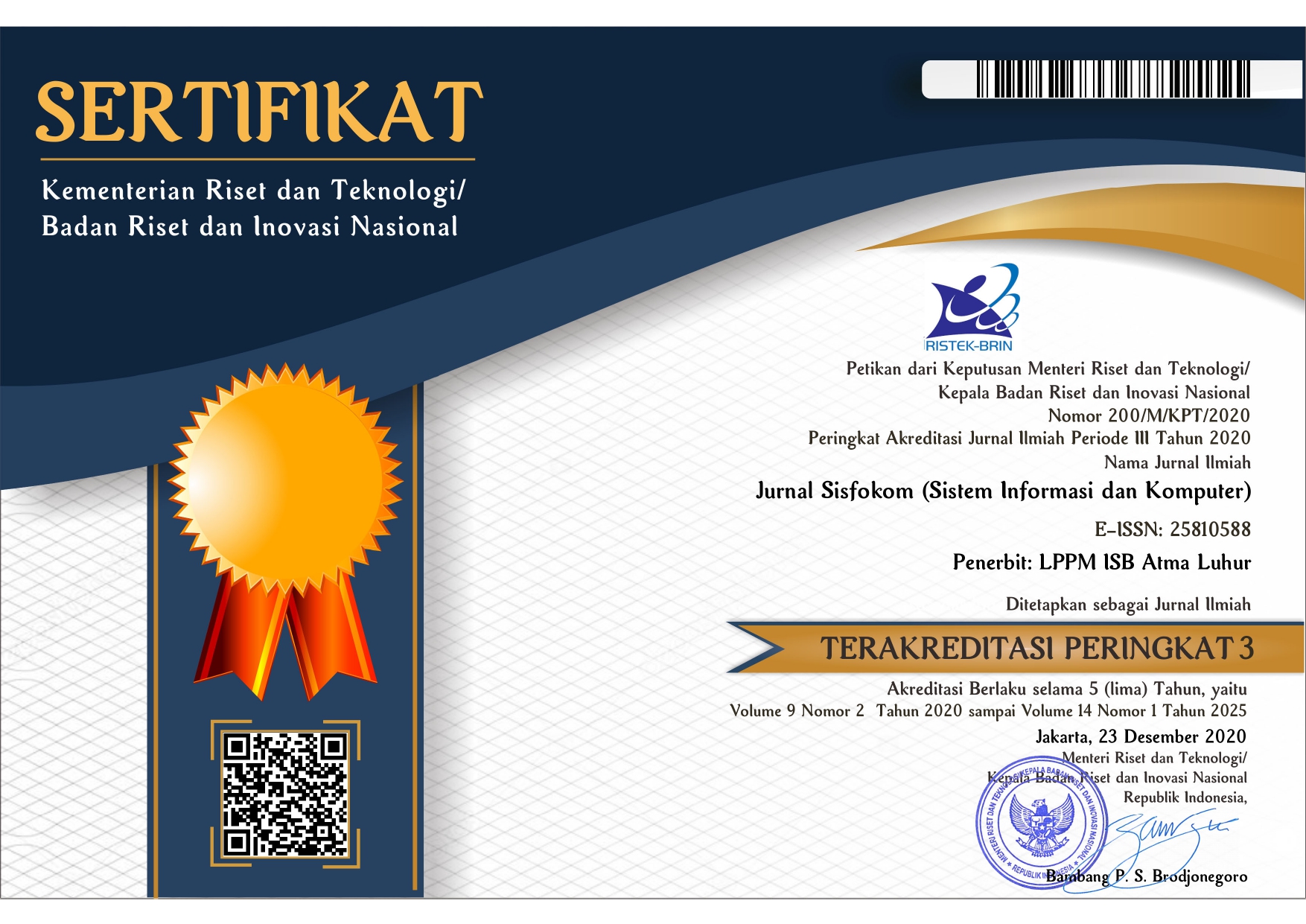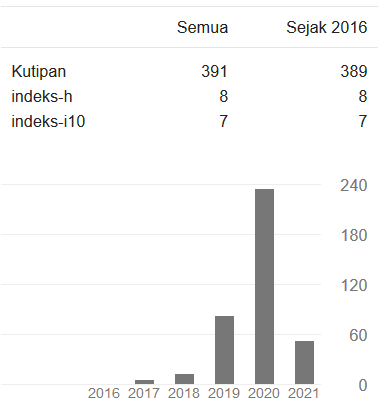Analisis Prediksi Kelulusan Mahasiswa Menggunakan Decission Tree Berbasis Particle Swarm Optimization
DOI:
https://doi.org/10.32736/sisfokom.v9i1.756Keywords:
Decision Tree, Student Graduation, Particle Swarm OptimizationAbstract
Good accreditation results are the goal of the college. With good accreditation, prospective students can glance at and enter the tertiary institution. To achieve this, there are several aspects that affect good accreditation results, one of which is graduate students who play an important role in determining accreditation. Timely graduate students can benefit the college or a student. Graduates can be predicted before the final semester using a method one of which is the decision tree. Decision tree is a method that is simple and easy to understand by producing rules in the form of a decision tree, but using a decision tree model alone is not enough to produce optimal results. So we need a method for optimization that is particle swarm optimization with advantages can improve accuracy by eliminating unused features. From the results of research with primary data of 2000-2003 graduate students in Amik PPMI Tangerang explained that the particle swarm optimization method can increase accuracy by 87.56% and increase by 01.01% from the decision tree method with a value of 86.55%. From the particle swarm optimization method can also find out which unused attributes have no weight, so that way can improve accuracy. From the results of the increase, it can be used by the Amik University of Tangerang to prevent students from graduating on time.References
V. Riyanto, A. Hamid, and Ridwansyah, “Prediction of Student Graduation Time Using the Best Algorithm,” Indones. J. Artif. Intell. Data Min., vol. 2, no. 2, pp. 1–9, 2019.
F. A. Freitas and L. J. Leonard, “Maslow’s hierarchy of needs and student academic success,” Teach. Learn. Nurs., vol. 6, no. 1, pp. 9–13, 2011.
M. V. Ashok and A. Apoorva, “Data mining approach for predicting student and institution’s placement percentage,” 2016 Int. Conf. Comput. Syst. Inf. Technol. Sustain. Solut. CSITSS 2016, pp. 336–340, 2016.
M. T. Devasia, M. V. T. P, and M. V. Hegde, “Prediction of Students Performance using Educational Data Mining,” Int. J. Cogn. Ther., vol. 1, no. 3, pp. 266–279, 2008.
Suhardjono, G. Wijaya, and A. Hamid, “PREDIKSI WAKTU KELULUSAN MAHASISWA MENGGUNAKAN SVM BERBASIS PSO,” Bianglala Inform., vol. 7, no. 2, pp. 97–101, 2019.
Ridwansyah and E. Purwaningsih, “Particle Swarm Optimization Untuk Meningkatkan Akurasi Prediksi Pemasaran Bank,” J. PILAR Nusa Mandiri, vol. 14, no. 1, pp. 83–88, 2018.
H. M. Nawawi, S. Rahayu, J. J. Purnama, and S. I. Komputer, “Algoritma c4.5 untuk memprediksi pengambilan keputusan memilih deposito berjangka,” J. Techno Nuasa Mandiri, vol. 16, no. 1, pp. 65–72, 2019.
J. Han and M. Kamber, Data Mining Concept and Techniques. India: New Age International Limited, 2006.
Wu and Kumar, The Top Ten Algorithms in Data Mining. USA: CRC Press, 2009.
C. A. Sugianto, “Penerapan Teknik Data Mining Untuk Menentukan Hasil Seleksi Masuk Sman 1 Cibeber Untuk Siswa Baru Menggunakan Decision Tree,” Tedc, vol. 9, pp. 39–43, 2015.
F. Gorunescu, Data Mining: Concepts, Models and Technique. 2011.
D. Setiawati, I. Taufik, J. Jumadi, and W. B. Zulfikar, “Klasifikasi Terjemahan Ayat Al-Quran Tentang Ilmu Sains Menggunakan Algoritma Decision Tree Berbasis Mobile,” J. Online Inform., vol. 1, no. 1, p. 24, 2016.
H. Liu, H. Q. Tian, C. Chen, and Y. F. Li, “An experimental investigation of two Wavelet-MLP hybrid frameworks for wind speed prediction using GA and PSO optimization,” Int. J. Electr. Power Energy Syst., vol. 52, no. 1, pp. 161–173, 2013.
T. Xu, Q. Peng, and Y. Cheng, “Identifying the semantic orientation of terms using S-HAL for sentiment analysis,” Knowledge-Based Syst., vol. 35, pp. 279–289, 2012.
J. Cao, H. Cui, H. Shi, and L. Jiao, “Big data: A parallel particle swarm optimization-back-propagation neural network algorithm based on MapReduce,” PLoS One, vol. 11, no. 6, pp. 1–17, 2016.
W. Dai and J. W, “A mapreduce implementation of C4.5 decision tree algorithm,” in nternational Journal ofDatabase Theory and Application, 2014, pp. 49–60.
L. Bin and Y. Min, “Analysis model
Downloads
Published
Issue
Section
License
The copyright of the article that accepted for publication shall be assigned to Jurnal Sisfokom (Sistem Informasi dan Komputer) and LPPM ISB Atma Luhur as the publisher of the journal. Copyright includes the right to reproduce and deliver the article in all form and media, including reprints, photographs, microfilms, and any other similar reproductions, as well as translations.
Jurnal Sisfokom (Sistem Informasi dan Komputer), LPPM ISB Atma Luhur, and the Editors make every effort to ensure that no wrong or misleading data, opinions or statements be published in the journal. In any way, the contents of the articles and advertisements published in Jurnal Sisfokom (Sistem Informasi dan Komputer) are the sole and exclusive responsibility of their respective authors.
Jurnal Sisfokom (Sistem Informasi dan Komputer) has full publishing rights to the published articles. Authors are allowed to distribute articles that have been published by sharing the link or DOI of the article. Authors are allowed to use their articles for legal purposes deemed necessary without the written permission of the journal with the initial publication notification from the Jurnal Sisfokom (Sistem Informasi dan Komputer).
The Copyright Transfer Form can be downloaded [Copyright Transfer Form Jurnal Sisfokom (Sistem Informasi dan Komputer).
This agreement is to be signed by at least one of the authors who have obtained the assent of the co-author(s). After submission of this agreement signed by the corresponding author, changes of authorship or in the order of the authors listed will not be accepted. The copyright form should be signed originally, and send it to the Editorial in the form of scanned document to sisfokom@atmaluhur.ac.id.








